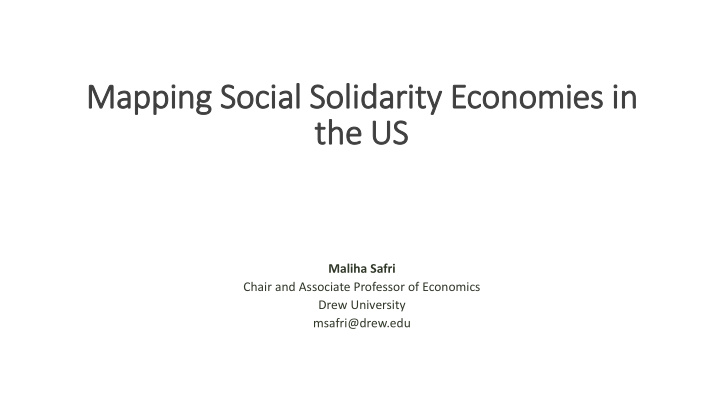



Mapping Social Soli lidarity Economies in in the US Maliha Safri Chair and Associate Professor of Economics Drew University msafri@drew.edu
Mapping Alterity in the Economy • National Science Foundation Funded Project • 2 Economists (Maliha Safri and Emily Kawano), 2 Geographers (Stephen Healy and Marianna Pavlovskaya), 1 Political Scientist (Craig Borowiak) • Mixed methods research (qualitative and quantitative) • 3 research sites: NYC, Philadelphia, Massachusetts • Outcomes: GIS Analysis, Economic Contribution analysis, interactive web platform usable by public and economic actors
Cirandas - Brazil Data Commons Worcester, MA ZOES - Italy Jersey Shore SolidarityNYC Boston New Economics Institute REAS - Spain
Guiding Research Questions • Where and how many SE entities? • Estimating aggregate economic impact of the SE • Qualitative effects on individuals and communities? • Structural constraints? • Which communities ARE and ARE NOT served by different SE practices? • Are there Gendered patterns? Racialized patterns?
An Organiz izational Typology of Social l Soli lidarity Economy Entit ities in in US
Inventories in Philadelphia and New York City Attribute # of entities in # of locations in # of entities in # of locations in Philadelphia Philadelphia NYC NYC Artist collectives 1 1 14 14 Childcare coops 3 3 34 34 Community gardens 53 53 539 539 Credit unions 12 15 127 158 Community supported 7 8 72 85 agriculture Food coops 1 1 16 16 Housing coops 152 305 1520 3059 Intentional communities 1 1 10 10 Worker coops 10 10 102 102 other 2 2 22 22 Community land trusts 10 10 Participatory budgeting 22 of 51 districts Alternative currencies & 1 Time Banks Total 242 399 2489 4049
Solidarity Economy Organizations & Per Capita Income New York City
Solidarity Economy Organizations & Per Capita Income Philadelphia
Partnering with Urban Homesteading Assistance Board
Partnering with Urban Homesteading Assistance Board
Race and Gender in the SSE in NYC We find that the SSE practices we examine have a spatial footprint spreading across the Bronx, Manhattan, and Brooklyn, (the three most populous boroughs) but not significantly across Staten Island or Queens. Although there is unevenness in the SSE, it has a relatively large and scalable presence across the city. We find that several types of SSE organizations concentrate heavily where poor, Latino, and Black populations live in three boroughs, but there are also wide swathes of those communities in which these practices do not concentrate. There is unevenness to the SSE, per type and overall, but each ensures resilience. We do not find SSE initiatives primarily clustering in high-income neighborhoods with concentrated White high-income populations. Strong gendered patterns in worker cooperatives, with implications for living wages in care work sectors
Recommend
More recommend